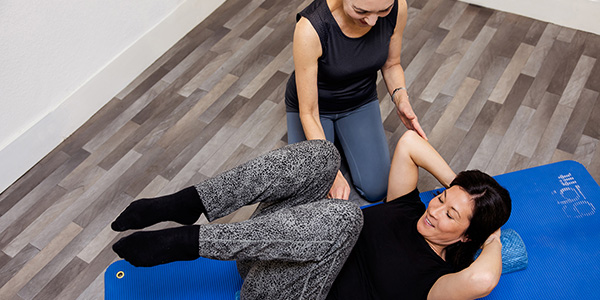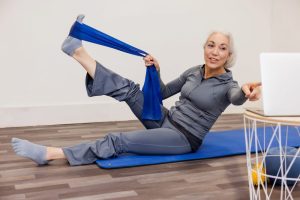Have you ever wondered if the words you use are exacerbating your chronic pain? How your thoughts and language influence how you feel, how you move and how you experience the world?
How many times have you been in chronic pain, ie pain that has lasted more than 3 months and felt afraid to move because you might “do yourself some damage”. How many times have you gone to a movement class and told your teacher “My back hurts so I have to be careful?”, or when the teacher asks if there are any injuries or niggles you respond with “Just the usual”. I hear this a lot in my classes and it got me thinking about language. As a Feldenkrais Practitioner, we are trained to consider the use of language on the nervous system even for simple things like “the knee hursts” instead of saying “my knee hurts”. As people, we are very good at disowning those areas of our skeletal system that cause us pain.
Have you ever thought about what happens interoceptively (inside of you) as soon as you use the phrase “be careful”? Well, in simple terms you’re nervous system goes into fight or flight mode which is an automatic response to an event or situation that is deemed stressful or frightening. So if you view certain exercises or movements with fear then you are triggering this response which exacerbates your pain, creates more fear causing your entire being to tense up, and stiffen restricting your ability to move with ease leading to your pain being exacerbated. You end up in a vicious cycle and begin your endless journeys to the GP, osteopath, chiropractor, physio, acupuncturist etc when all along you have the key to your own healing.
Let me explain.
What if you changed the narrative and instead of saying “be careful” you use the word “awareness”. “My back still hurts so I need to move with awareness”. Awareness allows you to move with intention. It allows us to sense and listen to your “self” so that you can begin the process of rewiring your brain’s response to movement.
Moving with Awareness means we have to adopt a new mindset so that we can allow ourselves to unlearn the fear of pain, unlearn our habitual way of doing things and instead learn to move with efficiency and ease and viewing movement as medicine.
Chronic pain whilst very real is, in most cases, no longer related to a structural injury. Instead it is created in the brain; our nervous system continues to send pain messages even though an injury may be healed and this is often related to our emotional and psychological state.
What if we also explore the role of our breath in movement and how our breath can help to reduce the anxiety we feel. Our breath is powerful and has many healing properties. Breathing fully, into the entire ribcage, sensing it expand like a balloon and feeling the gentle rising of the abdomen in tandem helps to produce chemicals in the brain leading to a sense of calm. When we breathe through our nose and slow down the breath we help to reduce our heart rate. Did you know that the optimal amount of breaths per minute is around 5.5 breaths? James Nestor, author of “Breath” considers this the prayer breathing rate because this is how many breaths many religions use during their chanting or prayers. The more breaths you take per minute the more anxious you probably are. How many breaths to do you take in a minute? Why not put a timer on for a minute, don’t look at it, close your eyes and breathe and count how many breaths you take in a minute. Slowing your breathing will calm you and in turn will also help to ease tension throughout your “self” and help you move with greater ease.
Try this:
Take a breath in through your nose and breathe out through your nose and notice where you feel movement. Place your hands on the two sides of the top of your ribcage just below your collar bone. Do you feel movement here? Is your sternum – breastbone – moving? What about the sides of the ribcage? Are these moving? And your abdomen? All these areas should be moving when we breathe efficiently.
Each time you take a breath in through your nose place your hands somewhere else so that you can feel movement.
If you don’t feel any movement, see if you can direct your breath to where your hands are and encourage the area to move.
Continue to breath in through your nose, focusing on the movement of your breath rather than any discomfort you may feel. Slow your breath down and make your exhalation longer than your inhalation. Try pausing after your exhalation before you inhale.
This simple practice can help reset the nervous system, reduce tension, and create a foundation for more fluid, pain-free movement.
So to summarise
Pain is not just a physical experience—it’s deeply connected to our nervous system. By changing the narrative from fear to awareness, we can retrain our brain to perceive movement as safe. This process takes time, but with patience, consistency, and the right mindset, we can break free from our chronic pain.
The next time you feel pain, instead of tightening up and resisting movement, take a breath. Let your ribs expand. Move with curiosity rather than fear. Over time, you’ll start to unlearn pain and rediscover ease in movement.
So as you continue your journey to healing, remember you don’t just want to manage your pain. You want to a create a relationship with your body, with your “self”, where movement is not to be feared but to be seen as your friend so you can move with more confidence and joy and achieve all the things you’d like to do in your life without pain.

Find out how it feels to become a Pilates student – come along to a class.



